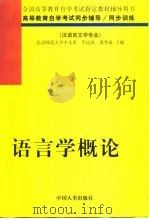《语言学概论》
| 作者 | 曹务堂 编者 |
|---|---|
| 出版 | 未查询到或未知 |
| 参考页数 | |
| 出版时间 | 1998(求助前请核对) 目录预览 |
| ISBN号 | 无 — 求助条款 |
| PDF编号 | 820079708(仅供预览,未存储实际文件) |
| 求助格式 | 扫描PDF(若分多册发行,每次仅能受理1册) |

Chapter 1Linguistics1
1.What is linguistics?1
2.What is a linguist?3
3.How does linguistics differ from traditional grammar?3
4.The scope of linguistics7
5.Synchronic study and diachronic study10
Chapter 2Language14
1.What is language?14
2.Some definitions of"language"15
3.The definition of language17
3.1Language as system18
3.2 Language as arbitrary18
3.3 Language as vocal19
3.4 Language as symbol19
3.5 Language as human20
3.6 Language as communication20
4.The design features of human language21
4.1Displacement23
4.2 Arbitrariness24
4.3 Productivity(Creativity)26
4.4 Duality27
4.5 Cultural transmission28
4.6 Interchangeability30
4.7 Discreteness30
4.8 Specialization31
5.The origin of language31
5.1The divine source32
5.2 The natural sounds source34
5.3 The oral-gesture source35
5.4 "Functional"theories36
Chapter 3Phonetics38
1.What is phonetics?38
2.Three branches of phonetics39
2.1Articulatory phonetics39
2.2 Acoustic phonetics39
2.3 Perceptual(Auditory)phonetics39
3.The speech organs40
4.Voiced and voiceless sounds41
5.Vowels and consonants42
6.Consonants43
6.1Place of articulation43
6.2 Manner of articulation45
6.3 The classification of consonants47
7.Vowels49
7.1Classification of pure vowels(monophthongs)49
7.2 Diphthongs51
8.The phonemes52
9.Allophone54
10.Phonetic transcription55
10.1The need for phonetic transcription55
10.2 The International Phonetic Alphabet56
10.3 Narrow and broad transcriptions56
Chapter 4Phonology62
1.What is phonology?62
2.Minimal pairs and free variation63
3.Phonemic contrast and complementary distribution64
4.Phonetic similarity65
5.Level of representation66
6.Phonological rules68
6.1Aspiration69
6.2 Vowel lengthening70
6.3 Flapping71
6.4 Neutralization72
6.5 Vowel nasalization73
6.6 Assimilation rule74
6.7 Deletion rule75
6.8 Sequential rules77
7.Suprasegmental features78
7.1Segmental features78
7.2 The syllable79
7.3Stress81
7.3.1 Word stress82
7.3.2 Sentence stress84
7.4 Rhythm85
7.5 Pitch86
7.6Intonation87
7.6.1 What is intonation?87
7.6.2 The structure of intonation88
7.6.3 The functions of intonation89
Chapter 5Morphology96
1.What is morphology?96
2.What is a"word"?97
3.Open versus closed class words101
4.Word classes103
5.Word-formation processes111
5.1Coinage111
5.2 Borrowing111
5.3 Compounding112
5.4 Conversion115
5.5 Derivation116
5.6 Blending116
5.7 Clipping117
5.8 Acronyms118
5.9 Backformation119
6.Morphemes120
6.1What is a morpheme?120
6.2 Morphemes and phonemes122
6.3 Morphemes and syllables122
6.4 Morphemes and semantic features123
6.5Types of morphemes124
6.5.1 Free morphemes125
6.5.2 Bound morphemes125
6.5.3Inflectional and derivational morphemes127
6.5.3.1 Inflectional affixes127
6.5.3.2 Derivational affixes129
6.5.3.3 Differences between inflectional affixes and derivational affixes130
6.6 Problems in morphological description138
7.Allomorph139
7.1Phonological conditioning140
7.2 Lexical conditioning142
Chapter 6Syntax150
1.What is syntax?150
1.1The phrase151
1.2 The clause153
1.3The sentence157
1.3.1 The definition of a sentence157
1.3.2 Types of sentences159
1.3.3 Above the sentence163
2.The traditional approach to syntax165
2.1The Reed-Kellogg diagram165
2.2 The prescriptive approach166
2.3 The descriptive approach168
3.The structuralist approach169
3.1Sentence pattern169
3.2 Syntagmatic and paradigmatic relations170
3.3Immediate constituent analysis172
3.3.1 Immediate constituent172
3.3.2 Different types of diagrams of IC analysis173
3.3.3 Ultimate constituent177
3.3.4 Endocentric and exocentric constructions178
3.3.5 Advantages and disadvantages of IC analysis179
3.3.6 Discontinuous constituents186
3.4 Structural ambiguity188
4.The transformational-generative approach191
4.1Performance and competence191
4.2Generative grammar194
4.2.1 What is generative grammar?194
4.2.2 Some properties of generative grammar195
4.2.3 Deep structure and surface structure198
4.3Transformational grammar200
4.3.1 The standard theory200
4.3.2 Phrase structure rules202
4.3.3 Embedding and center embedding209
4.3.4Case grammar212
4.3.4.1 What is case grammar?212
4.3.4.2 Types of cases215
4.3.4.3 Advantages of case grammar218
Chapter 7Semantics226
1.What is semantics?226
2.What is meaning?228
2.1Meaning as naming229
2.2 Meaning as concept230
2.3 Meaning as behaviour233
2.4 Meaning as context234
2.5 Meaning as use235
3.Types of meaning236
3.1The traditional approach236
3.2 The functional approach236
3.3 The pragmatic approach237
4.Word meaning238
4.1Sense and reference238
4.2 Meaning properties240
4.3Meaning relations241
4.3.1 Synonymy242
4.3.2 Antonymy243
4.3.3 Hyponymy245
4.3.4 Homonymy and polysemy247
4.3.5 Overlap248
4.4 Componential analysis249
5.Sentence meaning252
5.1How to define the meaning of a sentence?252
5.2 Meaning properties253
5.3Meaning relations255
5.3.1 Entailment255
5.3.2 Presupposition256
5.3.3 Inconsistency258
Chapter 8Pragmatics266
1.What is pragmatics?266
2.The message model of linguistic communication268
2.1What is message model?268
2.2 Problems with the message model269
3.Context and meaning273
4.Deixis274
4.1What is deixis?274
4.2Classification of deixis274
4.2.1 Person deixis275
4.2.2 Place deixis275
4.2.3 Time deixis275
5.Linguistic meaning and speaker meaning275
6.Speech act theory277
6.1What is speech act theory?277
6.2 Illocutionary acts279
6.3 Classification of illocutionary acts280
6.4 Felicity conditions282
6.5 Explicit vs.nonexplicit illocutionary acts283
6.6 Expressed vs.implied locutionary acts285
6.7 Literal vs.nonliteral locutionary acts287
6.8 Indirect speech acts287
6.9 Difficulties in speech act theory290
7.Conversational analysis291
7.1Openings291
7.2 Taking it in turns293
7.3 Repairs294
7.4 Closings295
8.Implicature296
9.The cooperative principle297
9.1What is the cooperative principle?297
9.2 The four conversational maxims298
9.3 Violations of the maxims299
10.The politeness principle304
10.1What is the politeness principle?304
10.2 The six maxims of politeness principle306
Chapter 9Language Change322
1.The changing language322
2.The history of English322
2.1Old English323
2.2 Middle English324
2.3 Modern English325
3.Language change327
3.1Phonological change327
3.2The causes of phonological change328
3.2.1 Loss328
3.2.2 Addition329
3.2.3 Metathesis331
3.2.4 Assimilation332
3.2.5 Dissimilation332
3.3 Morphological change333
3.4 Syntactical change335
3.5Lexical change337
3.5.1 Addition of new words337
3.5.2 Loss of words339
3.5.3Semantic change339
3.5.3.1 Narrowing340
3.5.3.2 Broadening341
3.5.3.3 Degradation341
3.5.3.4 Elevation342
3.5.3.5 Folk etymology342
4.The process of change343
Chapter 10Sociolinguistics347
1.What is sociolinguistics?347
2.Varieties of language348
2.1Dialect349
2.1.1 Accent and dialect351
2.1.2Regional dialect352
2.1.2.1 Regional lexical dialect354
2.1.2.2 Regional phonological dialect356
2.1.3Social dialect358
2.1.3.1 Education359
2.1.3.2 Occupation360
2.1.3.3 Sex360
2.1.3.4 Age362
2.1.3.5 Race363
2.1.3.6 Social class365
2.1.4 Standard dialect366
2.2Style and register367
2.2.1 Stylistic lexical variation368
2.2.2 Stylistic phonological variation369
2.2.3 Stylistic morphological variation369
2.2.4 Stylistic syntactic variation370
2.3Other language varieties371
2.3.1 Lingua francas371
2.3.2 Pidgins371
2.3.3 Creoles372
2.3.4 Slang373
2.3.5 Taboo language374
2.3.6 Code switching375
3.Bilingualism378
4.Diglossia379
5.Language planning381
Chapter 11Psycholinguistics386
1.What is psycholinguistics?386
2.First language acquisition387
2.1What is language acquisition?387
2.2 Principles of language acquisition388
2.3 Theories of language acquisition393
2.4Stages of language acquisition398
2.4.1 The babbling stage399
2.4.2 The one-word stage400
2.4.3 The two-word stage402
2.4.4 Telegraphic speech to full competence403
3.Speech production405
4.Speech perception409
5.Language and thought413
5.1Language determines thought413
5.2 Sapir-Whorf hypothesis414
5.3 Thought determines language418
6.Language and the brain419
6.1The human brain419
6.2 Cerebral dominance420
6.3The language centers421
6.3.1 Broca's area422
6.3.2 Wernicke's area423
6.3.3 The angular gyrus423
7.Aphasia424
7.1Broca's aphasia424
7.2 Wernicke's aphasia425
7.3 Conduction aphasia426
7.4 Alexia and agraphia427
Chapter 12Applied linguistics432
1.What is applied linguistics?432
2.Second language learning432
2.1Second language and foreign language432
2.2 Acquisition and learning433
2.3 Motherese and teacher talk434
2.4 Second language learning environment436
2.5 Comparing L1 and L2 acquisition437
2.6 Interference438
2.7Methods of analysis439
2.7.1 Contrastive analysis440
2.7.2 Error analysis441
3.Teaching methodologies443
3.1Grammar translation method443
3.2 Direct method445
3.3 Audiolingual method446
3.4 The communicative approach448
3.5 The silent way449
3.6 Suggestopedia451
3.7 Total physical response453
3.8 Community language learning454
3.9 The natural approach457
4.Testing459
4.1What is a test?459
4.2 Types of tests460
4.3Principles of language testing463
4.3.1 Practicality464
4.3.2 Reliability465
4.3.3 Validity466
Bibliography472
1998《语言学概论》由于是年代较久的资料都绝版了,几乎不可能购买到实物。如果大家为了学习确实需要,可向博主求助其电子版PDF文件。对合法合规的求助,我会当即受理并将下载地址发送给你。
高度相关资料
-

- 语言学概论
- 1983 南宁:广西人民出版社
-

- 语言学概论
- 1998
-

- 语言学概论
- 1939年04月 中华书局
-

- 语言学概论
- 1956 时代出版社
-

- 语言学概论
- 1999 开封:河南大学出版社
-

- 语言学概论
- 1985 三民书局股份有限公司
-

- 语言学概论
- 1992 厦门:厦门大学出版社
-

- 语言学概论
- 1992 北京:语文出版社
-

- 语言学概论
- 1994 太原:山西高校联合出版社
-

- 语言学概论
- 1988 北京:高等教育出版社
-

- 语言学概论
- 1985 福州:福建教育出版社
-

- 言语学概论
- 1931 商务印书馆
-

- 语言学概论
- 1957 天津:天津人民出版社
-

- 语言学概论
- 1998 北京:中国人事出版社
-

- 语言学概论
- 1981 华中工学院出版社
提示:百度云已更名为百度网盘(百度盘),天翼云盘、微盘下载地址……暂未提供。➥ PDF文字可复制化或转WORD